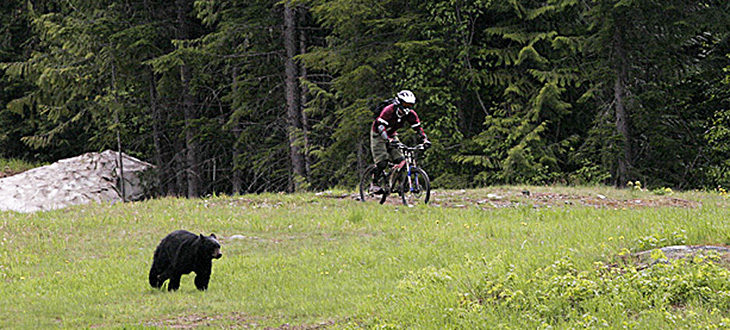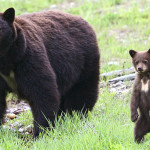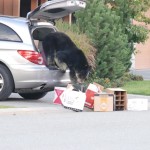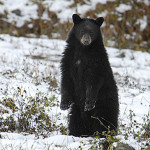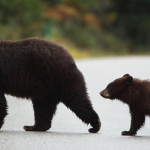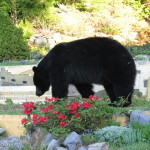Bears and Bikes
Mountain bikers are at higher risk for bear encounters, because they move quickly down a trail and are relatively quiet. Below are some tips for how you can keep yourself safe while biking in bear country.
Slow down – Bears often react defensively when they are surprised. There have been instances where bikers have been seriously injured and even killed by bears acting in self-defense. Be careful and consider slowing down in areas with poor sight distance (i.e. heavily wooded areas with lots of blind corners).
Carry bear spray – Bikers should carry bear spray in a holster/mount on their person. In a group, all riders should carry bear spray, so if one rider comes across another in trouble, they can take quick action. Bear spray can be used on all animals including cougars. To use bear spray, remove the safety clip, hold the can in two hands and extend your arms in readiness. Deploy 2-3 bursts when the bear is 10 m away. Take aim at the ground in front of the bear and then place the next burst higher and then higher again, never aiming above the head. Keep wind direction in mind and adjust accordingly. Try not to use the entire contents as more than one application may be needed. Spray again if the bear continues to approach; this time aim for the face (nose, mouth and eyes). Once the bear has retreated or is busy cleaning itself, leave the area as quickly as possible, but do not run or ride too quickly; alternatively, get to an area of safety, such as a car or building.
Make noise – Mountain bikers don’t generate much noise, increasing the odds of a surprise encounter with a bear (especially a mother with cubs who may not be able to move them out of the way quickly). Shout periodically, human voice is much more effective than a bear bell as bears do not associate bells with humans.
Look up – Look ahead and be vigilant. Keep an eye out for bear activity such as tracks, scat and feeding sites (berry bushes). Do not ride in areas with rich sources of bear food, like berry patches in late summer. Do not ride with headphones in as it makes you less likely to hear or notice wildlife in the surrounding area.
Don’t ride alone – Riding in a group will generate more noise and you will be more capable of responding to a rider in trouble.
Don’t ride at dusk or dawn – Bears are more active at this time and the likelihood you will encounter a bear increases.
If you encounter a bear – If you find yourself in close quarters with a bear, stop riding and assess the situation. Place the bike between you and the bear which makes you look larger in a non-threatening way.
When you’re on a bike, you’re moving swiftly and you have less time to react than someone who is walking. This is more likely to provoke a charge from a defensive bear, especially a grizzly bear. If a bear charges you in a defensive, non-predatory situation, it is usually a bluff (especially if it’s a black bear). Even so, this is a frightening experience. Hold your ground and do not make direct eye contact with the bear. Running or pedaling away may trigger the bear to chase you, and you can’t always out-bike a bear.
Yelling at a defensive bear may provoke it further. Instead, talk to the bear calmly and back away slowly until the bear resumes its normal behavior (resting, feeding, and traveling). If a bear looks like they intend to make contact, bear spray is your first line of defense. If a bear does make contact, remain as calm as possible and don’t move or make sounds. This will let the bear know that you have no intent to fight back or harm them – it is your best chance of minimizing injury to yourself.
Sometimes you may see a bear before it is aware of you. If this happens, move away quietly the way you came and give the animal the room it needs. Find an appropriate place to observe it, where possible, and enjoy the moment. It’ll certainly be one you won’t forget!

